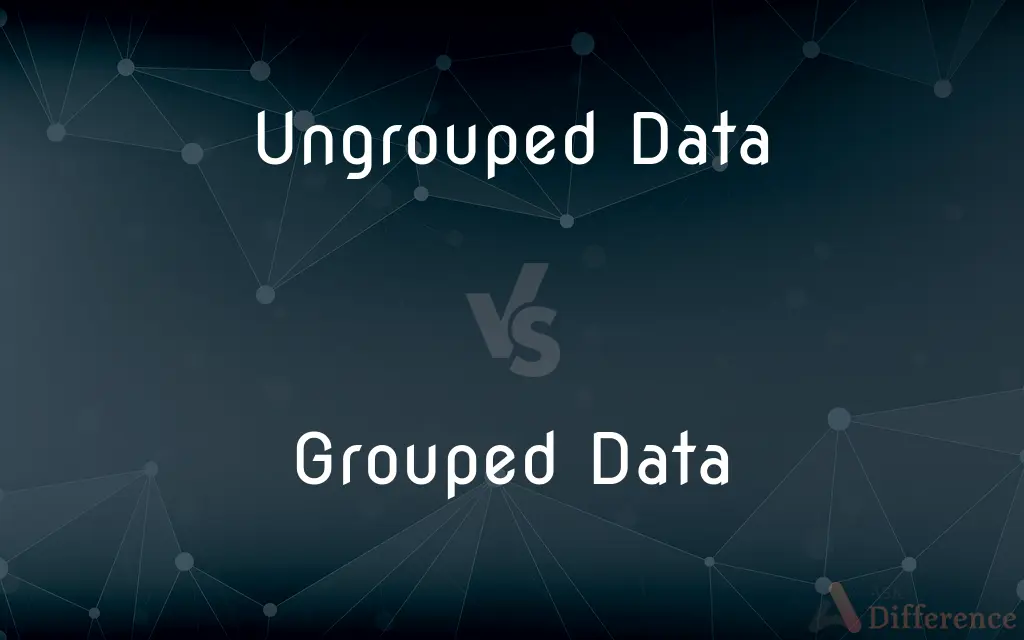Ungrouped Data vs. Grouped Data — What's the Difference?
By Tayyaba Rehman & Fiza Rafique — Published on October 18, 2023
Ungrouped Data: Individual data points listed. Grouped Data: Data organized into intervals or categories.

Difference Between Ungrouped Data and Grouped Data
Table of Contents
ADVERTISEMENT
Key Differences
Ungrouped Data refers to raw data points listed in their original form without any classification or grouping. Each value in the set stands alone, and no specific order or structure binds these values. For instance, in a classroom setting, if you have the exact score of every student in a test, it would be Ungrouped Data.
Grouped Data, on the other hand, represents data that has been sorted or classified into different intervals or categories. Instead of listing every individual data point, values are grouped based on certain criteria or range. Taking the classroom example further, if the students' scores are divided into grade intervals (like 90-100, 80-89, etc.), the data becomes Grouped Data.
Ungrouped Data is beneficial when precise individual values are needed, and detailed analysis on each specific point is essential. This data is often the starting point in many statistical analyses. Grouped Data provides a more general overview and is useful when patterns, trends, or distributions are the focus of the study.
With Ungrouped Data, there's a higher level of granularity and detail, which might be necessary for in-depth analyses. With Grouped Data, the details are condensed into categories or intervals, making it easier to visualize and interpret in cases where specific data point accuracy is not the main concern.
Both Ungrouped Data and Grouped Data have their merits. The choice between them largely depends on the research question, the data's nature, and the kind of insights or information that one wishes to derive from the analysis.
ADVERTISEMENT
Comparison Chart
Organization
Individual data points.
Data in intervals or categories.
Detail Level
High granularity.
Condensed, broader view.
Use Case
Detailed analysis on individual values.
Overview, patterns, and distributions.
Visualization
Individual data points plotted.
Histograms or bar charts with intervals.
Examples
Exact scores of students.
Score ranges like 90-100, 80-89, etc.
Compare with Definitions
Ungrouped Data
Raw, individual data values.
The list of every student's exact age in a class is Ungrouped Data.
Grouped Data
Condensed data for general overview.
Categorizing animals based on diet types is Grouped Data.
Ungrouped Data
Unaggregated data entries.
The daily number of website visitors is Ungrouped Data.
Grouped Data
Data sorted into intervals or categories.
Dividing book sales into genres represents Grouped Data.
Ungrouped Data
Data without categorization.
Daily temperature readings for a month represent Ungrouped Data.
Grouped Data
Structured data for broad analysis.
Dividing customer feedback into positive, neutral, and negative is Grouped Data.
Ungrouped Data
Distinct data points without condensation.
Exact heights of every plant in a garden is Ungrouped Data.
Grouped Data
Organized data points based on criteria.
Age groups like 0-10, 11-20, etc., are forms of Grouped Data.
Ungrouped Data
Values not classified into intervals.
Individual sales figures for each day is Ungrouped Data.
Grouped Data
Data that aids in visualizing patterns.
Income brackets for a population survey are Grouped Data.
Common Curiosities
Why would one use Grouped Data?
Grouped Data provides a broad overview, making it easier to identify patterns or trends.
Can Ungrouped Data be converted into Grouped Data?
Yes, Ungrouped Data can be classified into intervals or categories to create Grouped Data.
How is Grouped Data different from Ungrouped Data?
Grouped Data organizes data into intervals or categories, while Ungrouped Data presents individual points.
When is Ungrouped Data useful?
Ungrouped Data is beneficial for detailed analyses requiring specific data point accuracy.
How is Grouped Data typically visualized?
Grouped Data is often visualized using histograms, bar charts, or pie charts based on intervals or categories.
What is Ungrouped Data?
Ungrouped Data lists individual data points in their raw form without categorization.
Which data type is better for visual representations?
Grouped Data is often preferred for visual representations like histograms, as it summarizes trends.
Can you give an example of Grouped Data?
Age ranges, like 0-10, 11-20, etc., in a survey are examples of Grouped Data.
Is Ungrouped Data more detailed than Grouped Data?
Yes, Ungrouped Data provides more granularity as it lists individual values.
Can Grouped Data be changed back to Ungrouped Data?
Not always, once data is grouped, some specific details might be lost.
What is an example of Ungrouped Data?
A list of every student's exact test score in a class is an example of Ungrouped Data.
Which offers a quicker overview, Ungrouped Data or Grouped Data?
Grouped Data offers a quicker overview as it categorizes and summarizes information.
In which scenarios is Ungrouped Data essential?
When precise details and in-depth individual analyses are required, Ungrouped Data is essential.
Is every individual value shown in Grouped Data?
No, Grouped Data condenses values into categories, masking individual data points.
Which data type, Ungrouped Data or Grouped Data, is more suitable for large datasets?
Grouped Data is often more manageable for very large datasets as it summarizes and categorizes information.
Share Your Discovery

Previous Comparison
Pacific Time vs. Mountain Time
Next Comparison
Wilderness vs. OutbackAuthor Spotlight
Written by
Tayyaba RehmanTayyaba Rehman is a distinguished writer, currently serving as a primary contributor to askdifference.com. As a researcher in semantics and etymology, Tayyaba's passion for the complexity of languages and their distinctions has found a perfect home on the platform. Tayyaba delves into the intricacies of language, distinguishing between commonly confused words and phrases, thereby providing clarity for readers worldwide.
Co-written by
Fiza RafiqueFiza Rafique is a skilled content writer at AskDifference.com, where she meticulously refines and enhances written pieces. Drawing from her vast editorial expertise, Fiza ensures clarity, accuracy, and precision in every article. Passionate about language, she continually seeks to elevate the quality of content for readers worldwide.
















































